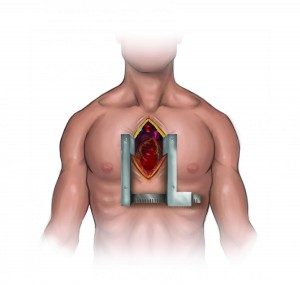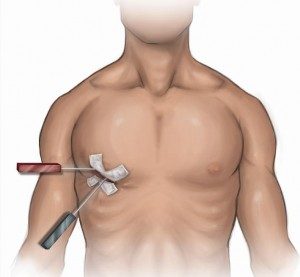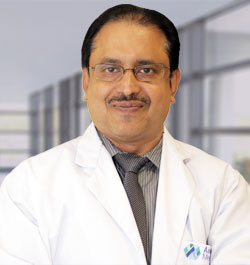
Minimally invasive heart surgery (also called keyhole surgery) is performed through small incisions, sometimes using specialized surgical instruments. The incision used for minimally invasive heart surgery is about 3 to 4 inches instead of the 6- to 8-inch incision required for traditional surgery.
The traditional heart surgery procedure

Open heart surgery is typically done through a vertical cut placed over the middle of the chest, including full division of the breastbone.While most patients tolerate this well, it can take around 12 weeks or more before the wound is completely healed. This can seriously delay a return to normal activities. These days, it is often possible to avoid such invasive options and, depending upon the specific case, certain procedures may be appropriate for keyhole surgery.
Keyhole heart surgery
Other surgical specialties have embraced keyhole therapies with great success. A good example is gall bladder surgery, where patients are now offered day case procedures when previously they were in hospital for up to 10 days. Keyhole approaches during heart surgery can produce equally dramatic improvements for patients, as well as offering considerable cosmetic benefits.

A much smaller wound means less surrounding tissue damage, often without any broken bone, which in turn can lead to faster recovery, sometimes in just 10 days. In this situation, patients will often spend less time in hospital, and can return to their normal activities more quickly. In addition, the keyhole surgery option results in significantly less scarring for a better cosmetic outcome. Keyhole techniques can also create benefits for healthcare in general by reducing the burden of supportive treatment required following heart surgery.
How is keyhole heart surgery performed?
The minimally invasive surgery is performed using the most up-to-date and sophisticated technology currently available. This allows the surgeon to carry out the procedure remotely using small surgical instruments. He/she monitors every move on a video screen, as images are broadcast to the screen from a tiny digital camera inserted through the side of the chest. The surgeon also has at his disposal a robot capable of manoeuvering the camera and holding it perfectly still.
What are the risks of keyhole heart surgery?
The possible complications for keyhole surgery are the same as for open chest surgery. Results from Europe and the USA, where thousands of these procedures have taken place, indicate that the outcomes from minimally invasive surgery in experienced hands are as effective as traditional approaches through the breastbone (sternum), with the added benefits of more rapid recovery, and improved cosmetic appearance.
Is keyhole heart surgery right for me?
You may be suitable for keyhole surgery if you have any of the following conditions:
● Disease of the heart valves.
● Disease of the coronary arteries.
● Heart rhythm abnormalities such as atrial fibrillation.
● A hole in the heart (atrial septal defect).
● You have previously undergone open heart surgery through a sternotomy where a keyhole procedure may now be safer than a repeat sternotomy.
● You would like a better and more appealing cosmetic result.
Benefits of Minimally Invasive Surgical Techniques (Keyhole surgery)
The benefits of minimally invasive and robotic heart surgery techniques include:
1. Small incisions
2. Small scars
Other possible benefits may include:
1. Shorter hospital stay after surgery: The average stay is 3 to 5 days after minimally invasive surgery, while the average stay after traditional heart surgery is 7 to 10 days
2. Low risk of infection
3. Low risk of bleeding and blood transfusion
4. Shorter recovery time and faster return to normal activities/work: The average recovery time after minimally invasive surgery is 1 to 4 weeks, while the average recovery time after traditional heart surgery is 6 to 8 weeks. The recovery time and return to regular activities is shorter for patients who undergo robotically assisted heart surgery.
5. Division of the breastbone is not needed for robotically assisted heart surgery.

Congenital heart disease (CHD) is the most common congenital disorder in newborns. There are no published data on the occurrence of congenital heart disease in Kerala. However there is general agreement among health workers that it follows a similar pattern all over the world in different geographies. The reported prevalence of CHD at birth ranges from 6 to 13 per 1000 live births. On an average, 8 children are born with congenital heart defects for every 1000 live births in India. Variation is primarily due to the use of different methods to detect CHD (fetal echocardiography versus postnatal referral to a cardiac center). Deriving from the crude birth rate, it…
keep reading

Congenital heart disease (congenital heart defect) is an abnormality in your heart’s structure that you’re born with. Although congenital heart disease is often considered a childhood condition, advances in surgical treatment mean most babies who once died of congenital heart disease survive well into adulthood. While medical advances have improved, many adults with congenital heart disease may not be getting proper follow-up care. If you had a congenital heart defect repaired as an infant, you likely still need care as an adult. Symptoms Symptoms or signs of congenital heart disease may not show up until later in life. They may recur years after you’ve had treatment for a heart defect.…
keep reading

Minimally invasive heart surgery (also called keyhole surgery) is performed through small incisions, sometimes using specialized surgical instruments. The incision used for minimally invasive heart surgery is about 3 to 4 inches instead of the 6- to 8-inch incision required for traditional surgery. The traditional heart surgery procedure Open heart surgery is typically done through a vertical cut placed over the middle of the chest, including full division of the breastbone.While most patients tolerate this well, it can take around 12 weeks or more before the wound is completely healed. This can seriously delay a return to normal activities. These days, it is often possible to avoid such invasive options…
keep reading
about Dr sajan koshy
Pediatric Cardiac Surgeon

Dr Sajan Koshy MS MCh is currently heading the unit of Paediatric & Congenital heart surgery at Aster Medicity. Prior to joining Aster, he was working as senior consultant and head of the department of paediatric cardiac surgery at MIMS Calicut. He started his professional career from alleppey medical college in 1988. He also functioned as a co- convener in first and second symposia on perioperative care of congenital heart disease held in Kochi in the year 2002 and 2004 respectively & as the scientific committee chairman for the national CME of cardio thoracic surgery held at Calicut in September 2007. He has Conducted many lectures in all the districts of North Kerala for the benefit of medical professional bodies to create awareness about congenital heart disease.
read more